Your Burning Summer Sun Safety Questions, Answered By A Dermatologist

Summer is well underway, and if you’re like my family, we spend hours outside every day. My kids love to swim, ride bikes, play basketball and four square, and consume all of the popsicles. I’m right there with them, catching some fresh air and sun rays.
We are bombarded with sun safety information, but what’s legit and what’s not? Can we bend some of the rules? Scary Mommy checked with Dr. Lucy Chen, a board certified dermatologist of Riverchase Dermatology in Miami, to ask her all of our burning (see what I did there?) summer sun exposure questions.
The Ideal Sunscreen Exists
Have you ever stood in the sunscreen aisle at the store and felt confused and overwhelmed? Is more SPF better, and what’s the difference between UVB and UVA protection? Dr. Chen shares with us that the ideal sunscreen for both children and their parents has a minimum of 30 SPF (that’s sun protection factor), but she’d prefer we use an SPF of 50 that’s also “water-resistant” and is labeled as “broad spectrum.” Both UVB and UVA rays can cause sunburn and, down the road, skin cancer, so purchase a sunscreen that blocks them both. A lotion is easier in that you can “visibly see the amount you apply to the skin,” but if you prefer sunscreen in spray form, “be sure to coat the skin carefully and use a good amount.”
Sun-Safe Clothing Is a Good Option
Uwe Krejci/Getty
Dr. Chen shares that sun-safe clothing is a good option when it comes to protecting your skin from the sun’s harmful rays. For starters, you don’t have to reapply clothing like you do sunscreen, but keep in mind, sun-safe clothing doesn’t cover every inch of your body. She recommends darker and brighter colors that are more protective; they “absorb more UV rays.” Look for clothing labeled UPF 50 or greater. UPF is an acronym for “ultraviolet protection factor.” You don’t need to apply sunscreen under the clothing, but of course you need to apply sunscreen to any skin that isn’t covered by the clothing.
Makeup Isn’t Your Sole Sunblock
Dr. Chen states that makeup that includes SPF is fine, but it should be considered an addition, not the primary application of sun protection. She notes that “the amount of makeup applied to the skin is usually far less than the amount of sunscreen needed for adequate protection.” She recommends that you first apply your sunscreen, then your SPF-containing makeup. Sorry to break it to you, but this isn’t a one-and-done routine. You need to “reapply sunscreen throughout the day—especially if the UV index is high.”
Peak Sun Hours Can’t Always be Avoided
ozgurcankaya/Getty
When you can’t avoid those peak sun hours, which is true for many of us with kids, Dr. Chen wants us to throw on our sun-safe clothing such as hats, UV-protection sunglasses, and of course, keep up on that sunscreen application. You need to reapply sunscreen every two hours. “If you get your body wet or sweat excessively, reapply sunscreen immediately,” she warns. Also, be aware of your skin’s color. If you see a hint of red, you need to head out of the sun ASAP.
Safe Tans Don’t Exist
How many times have you heard someone say, “There’s no such thing as a safe tan” or “I’m going to get a base tan so I don’t burn”? Which one is correct? Dr. Chen informs that a tan is a result of “sun damaged skin cells” and the chances of skin cancer increase. She understands that many people enjoy basking in the sun and intentionally tanning, but she shares that “in the long run” we are “far better off avoiding tanning and using sun protection.”
But What About Vitamin D?
For years, we’ve heard that vitamin D is crucial to our health, so does that mean we should skip or skimp on the sunscreen? Dr. Chen says, “Vitamin D3 can be obtained from a variety of sources other than the sun.” Two such significant sources are “fatty fishes and fish liver oils.” There’s also the option to supplement. She acknowledges that some people crave catching rays for their mental health, to which she says, “15 minutes a day is plenty.”
People of Color Do Need Sun Protection
Dr. Chen shares, “Everyone, no matter their skin color, needs sun protection.” The idea that BIPOCs don’t need sunscreen comes from the false belief that because their skin tends to be darker in tone than a white person’s, they don’t need protection because they have built-in sunscreen from their melanin. However, Dr. Chen says that a person of any skin tone can “burn in the sun without sunscreen.” No matter your skin tone, you need to protect your skin.
Seeing a Dermatologist is Crucial
Did you know that even people in their twenties should see a dermatologist on a yearly basis? Dr. Chen says dermatologists check to see if there’s anything “suspicious” on your skin like “new lesions that itch or bleed” and moles. If you notice a sudden new mole or a mole that changes colors, get checked ASAP. Don’t assume you’re fine (or God forbid, diagnose yourself on the internet). Better safe than sorry, friends.
By all means, enjoy the great outdoors this summer. Just be aware that the sun’s rays should be seen as something to protect yourself and your kids from. Set up good sun safety habits now, teaching your kids to carry these into adulthood. Load up on sunscreen and sun-safe clothing, and have fun!
This article was originally published on